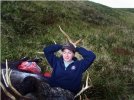This is a great thread David.
I was going to give two examples of how the recessed ricasso can be a problem in user knives, they don't seem necessary now but I will anyway. These are admittedly situations that most us will seldom need a knife for.
Once while trailing some pack mules to a spike camp, a troublesome mule kept rearing back any breaking his pigging string. (the pigging string is a small rope used when tailing horses and mules together in a pack string, it is supposed to break in a panick situation so that a mule in trouble doesn't drag the whole string off the mountain or down river if he should stumble) The mule in this situation, Rawhide, learned he could rear back and break the string at will and head back home with all the other mules behind him in the string. The skinner would have to tie up his remaining string, turn his mount around and chase after the skidaddling mules down the narrow mountain trails, when they were caught up too, you needed to get off the trail into the rocks and tussucks and get around the mules to head them off. It was a real pain. After Rawhide broke the string two or three times I decided I needed to break him of the habbit. I would need to tie him solid to the pack of the animal in front of him until he learned he couldn't break loose. This is very dangerous, because animals can get hurt and you can really tear up some gear, but I had to do something. While I was tieing his lead to the pack in front of him he (you guessed it) reared back and pinched the fingers of one hand in the Knot. I thought I was going to loose some fingers right then and there. While I was franticly grabbing for my belt knife to cut the rope the mule behind Rawhide, equally as frustrated with Rawhide as I was, reached up and bit him in the ass, Rawhide let loose on the rope just enough for me to get my hand loose, I had to look down to check for all my fingers. If I had needed the knife to slash at the rope a recessed ricasso would certainly have complicated things. The morral of the story, don't become a mule skinner.
In commercial fishing, we were always taught to have a knife on the body in case a net should snag on a button or zipper on your slickers while the net was paying out of the boat. I can see where the recess could cause a problem.
Knife design is certainly personal thing. For many that read this forum the ABS school of thought is highly regarded. For many customers in other markets some of the highly regarded aspects of knife design in the ABS are not important. It's a good thing we're not all trying to make knives for the ABS style market and it's a good thing that all customers don't only want to buy that knife. A customer for every maker and a maker for every customer, I say. I am looking foreward to becoming a JS and MS smith from a performance standpoint as well as design, but I am sure that I will always make knives that may not fit those design standards. I would not call anyones design choices wrong.
I personally like the way moose look, though I would not call them good looking, and not the smartest. There is something about a massive bull in a misty swamp on a crisp fall morning. The largest one I ever guided for was 74 inches wide, truely an impressive thing to see.
Anyway it's a great discussion.












